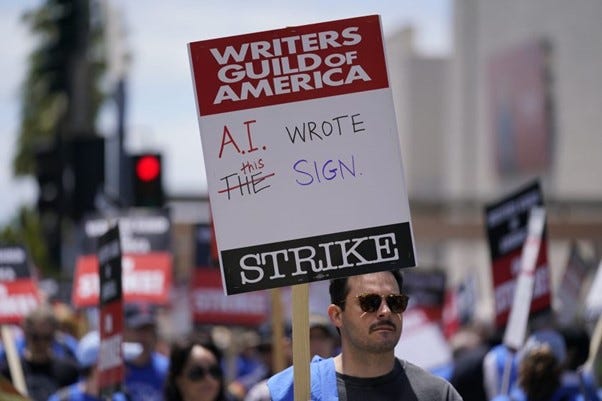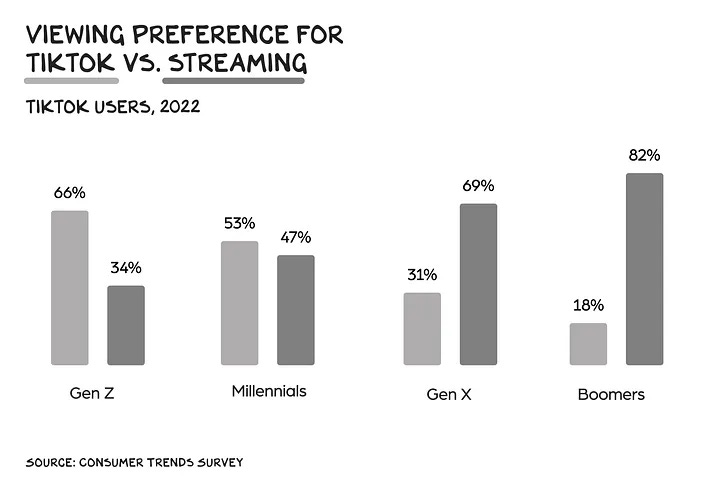Lights, Camera, Strike! The Blockbuster Battle Between Hollywood Workers and AI Machines
#WF45 From Luddites to Luvvies – what the first ever workers strike against AI tells us about the future of work

In a plot twist straight out of a Hollywood blockbuster, the film industry has recently witnessed a wave of strikes.
Writers, actors, and voice-over artists have downed their scripts in protest over pay and image rights.
This article aims to explore the recent strikes in the media industry, their implications for the future of work, and the emergence of new business models.
Lights, Camera, Strike!
The workers are campaigning for an increase in minimum pay, higher fees from streaming, protections of actors’ likeness from AI, and compensation for work used to train AI models.
160,000 members of the Screen Actors Guild (SAG-AFTRA) have joined the 11,500 from the Writers Guild of America.
The impact for viewers is that new productions will halt on popular shows such as Stranger Things Season 5, The Mandalorian, and Saturday Night Live.
The strikers are negotiating with the Alliance of Motion Picture and Television Producers (AMPTP), which represents 350 studios and streamers including Disney, Netflix, Warner Bros, Apple, and Amazon.
The industry standoff has been caused by many complex factors, including the impact of streaming technology. Spending on original streaming content has grown from $5 billion in 2019 to $19 billion in 2023.
Industry profits from just some of AMPTP members have ballooned from $5 billion in 2000 to $28-$30 billion from 2017-2021.
The Unions are negotiating for a more equitable deal for its’ members.
Streamberry Deep Fakery
Another item on the negotiating table is the use of the actor’s image in AI generated content.
Black Mirror is an influential and impactful TV series, reflecting and some say shaping changes in society. Memorable episodes include Nosedive – a society heavily influenced by social-media ratings, and Emmy-winning San Junipero and The Entire History Of You.
In the latest series, the episode, Joan is Awful, has played a role in driving anxiety about future livelihoods for actors and has been a catalyst for strike action.
The plot (no spoilers) follows an Executive, Joan, who discovers that her life is being adapted into a series starring Salma Hayek, by the Streamberry Corporation (aka Netflix). This is as dreadful as it sounds. The company uses a ‘quamputer’, quantum and computer, to generate artificial multiverses of Joan’s life.
The aim here is to launch unique, tailored content to each individual in our database, all 800 million of them, created on the fly by our system. The most relatable content imaginable. Mona Javadi – CEO Streamberry
The real Joan and Salma try and find a way to save the day with some rather messy plot twists.
Unlike other dystopian Black Mirror episodes with tragic endings, this one doesn’t need one because in some ways we are already living it. It turns out the most relatable content imaginable is our own dramatic history displayed on TikTok and Instagram.
If a satirical critique of the media industry produced by the major streaming player isn’t topsy-turvy enough for you. Here is Billionaire media mogul, Logan Roy, of Waystar RoyCo, giving his surprising perspective on the strike.
From Luddites to Luvvies – Workers vs. Technology Throughout History
“It’s not about food. It’s about keeping those ants in line.” Hopper, A Bugs Life
Workers protesting against the introduction of new technology is a classic storyline in the history of work.
It’s insulting to compare the Luvvies to the Luddites, who violently protested against the introduction of mechanised textile machinery. The writers and actors are not campaigning to ban AI – they are arguing for a fairer share of the profits.
There has been more industrial conflict than at any time over the past five years. Driven by cost of living increases, inflation, and the introduction of new technology.
In other industries, the AI threat is real to workers with companies like IKEA reporting that 47% of customer calls are now handled by an AI tool called Billie.
BT is expecting 11,000 jobs to be replaced by AI technology.
There is a global labor force of copywriters, designers, software developers, customer service agents, virtual assistants. Much of their work will be impacted by tools like Midjourney, Stable Diffusion, and ChatGPT type tools.
The introduction of new technology usually follows certain patterns, from the industrial revolution to the introduction of electricity and the railways. My essay outlines some trends and lessons from the five technology surges of the last 250 years and how we should try and build a preferable future of work.
The Entire History of Us
Joan is Awful picks up on another issue about consumer trends, that we do indeed find ourselves rather entertaining.
In a prolonged TV entertainment drought, we might hypothesise that people will re-watch every episode of Breaking Bad/Game of Thrones/Succession ever made, get obsessed by Bollywood, or resort to Victorian parlour games. But the reality is that we will continue to be glued to unscripted entertainment like TikTok - content made by gifted amateurs like us,
The average TikTok user watches the app for 95 minutes per day.
Those in their 20s and 30s, are much more likely to spend their time on TikTok than consume streaming content.
Is it possible that a bigger existential threat to actors and writers is the demand for unscripted content on social media rather than AI body doubles for a small number of big stars?
Will There Be Any Plot Twists?
"Hollywood has a way of commoditizing everything." Jake Gyllenhaal
It is the nature of the industry that a few actors get the most attention and gold.
Tom Cruise reportedly made $100 million from Top Gun: Maverick, and a cut of ticket sales.
However, 87.3% of SAG-AFTRA members earn less than $26,470/year which is the minimum level of earnings to qualify for the union’s health plan.
Will they get the salary, pay rates, insurance, and pension their talent deserves?
No, but pay rates and agreements with celebrities using deep-fake imagery will be agreed over time.
This will not help financial security for most members.
The nature of this work, mostly carried out by freelancers is unpredictable – this is not the story of rich actors like Tom Cruise clamouring for better pay, or AI image rights.
20th Century solutions such as campaigning for good pensionable jobs for all are unrealistic with the automation of work. Only 10% of Americans are union members.
Currently, not many of those in the movie industry have well paid steady jobs and pensions. There will be plenty of work to do in the future, but it will need to be organised differently. We need to reframe work itself and come up with better solutions for financial security. There are some ideas for building a fairer work ecosystem less reliant on formal jobs in my essay and 20 minute video.
We need new business models for the industry, rather than just reassurance over AI, or a 2% cut of streaming fees.
From Rags to Riches - Will New Business Models Emerge to Save the Industry?
The demand for new business models which give workers more equity, flexibility, and autonomy is increasing.
Here are four interesting ventures with different funding models to keep an eye on.
The Film Director, Steven Soderbergh, financed his indie film Experiment with Blockchain Financing through Roman Coppola’s Decentralised Pictures. This uses its own Digital Currency, FILMCoins, to create a funding and reward system. Francis Ford Coppola explains the idea here.
The Squad is a Web3 studio producing content and the orginators of the Film3 movement. The community includes Academy Award and Emmy winners, Goya nominees, writers, directors, producers, actors, collaborating to manifest a better future for filmmakers. Jordan Bayne is the founder of The Squad and her short film, The Sea Is All I Know was an Oscar contender.
Shibuya is a Web3 startup that helps creators with a full-stack solution to fund films and shorts, build community, and foster an engaged fanbase. Fans can fund their favourite films, participate in the creative process, and join communities for the films they love most.
Film.io is a decentralised filmmaking ecosystem, placing Hollywood decision-making into the hands of creators and fans. Film.io uses an AI-driven matchmaking system to pair filmmakers with funding, and on the flip side uses a blockchain-based algorithm called the ‘Go Score’ to monitor fan engagement and social media metrics, mitigating risk for financiers. The platform is governed using FAN tokens, whilst FILM tokens are used to pay back projects on the platform.
The Hollywood model for funding movies is historically centralised with a few blockbusters funding the duds. This requires big pockets, so it remains to be seen if more decentralised models can touch the mainstream or just be an emerging feature of independent film industry.
Series Finale
In the ongoing historical drama between the forces of Labour and Capital, will the writers become the heroes of their own narrative?
The strike will eventually be resolved, but what will be interesting is the impact of changing consumer tastes on the industry and the emergence of new business models.
Across different industries, more of us will be moving around contracts and projects like a jobbing actor.
For now, let’s hope we can access enough scripted entertainment to last us through the winter, and that the two parties come to an equitable agreement leading to a creative renaissance.






